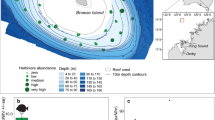Abstract
The aim of the study was to provide comparable estimates of abundance of herbivorous reef fishes at temperate and tropical localities using a standardized methodology. Faunas of herbivorous fish were sampled on the rocky reefs of temperate northern New Zealand and on the coral reefs of the northern Great Barrier Reef (GBR), Australia, and the San Blas Archipelago in the Caribbean. A pilot study established the most appropriate habitat setting and the scale and magnitude of replication for the sampling program in temperate waters. Herbivorous fishes, including members of families endemic to the southern hemisphere (Odacidae and Aplodactylidae), were most abundant in turbulent, shallow water (0 to 6 m) and had patchy distributions within this habitat. A hierarchical sampling program using 10-min transect counts within the 0 to 6 m depth stratum examined abundance patterns at a range of spatial scales including mainland and island coasts, localities separated by up to 100 km and sites separated by up to 10 km. This program identified a characteristic fauna of seven species of herbivorous fishes with mean total abundances ranging from 23 to 30 individuals per 10-min transect. Species composition of the fauna varied between islands and coasts. A similar methodology was used to sample the major families of herbivorous fish in a number of sites in each of the tropical regions. These sampling programs revealed a fauna dominated by acanthurids and scarids in both the GBR and Caribbean localities. Estimates of abundance from these regions were similar, with a mean of 108 individuals recorded on the GBR and 129 per 10-min transect in the Caribbean. Species richness varied between each region, with 44 taxa recorded from the GBR and 11 from the Caribbean. Abundances of temperate water herbivores in New Zealand were found to be 75 to 80% lower than those recorded from shallow water habitats sampled on coral reefs. This was not related to species richness, since both New Zealand and the Caribbean locality had patterns of low richness. We suggest that the differences in abundance found by our study between temperate and tropical regions are not restricted to herbivorous fishes, but are representative of general latitudinal trends in reef fish faunas.
Similar content being viewed by others
Author information
Authors and Affiliations
Additional information
Received: 4 November 1996 / Accepted: 15 December 1996
Rights and permissions
About this article
Cite this article
Meekan, M., Choat, J. Latitudinal variation in abundance of herbivorous fishes: a comparison of temperate and tropical reefs. Marine Biology 128, 373–383 (1997). https://doi.org/10.1007/s002270050103
Issue Date:
DOI: https://doi.org/10.1007/s002270050103




